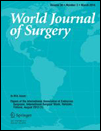Synchronous Bilateral Adrenalectomy for Cushing’s Syndrome: Laparoscopic Versus Posterior Retroperitoneoscopic Versus Robotic Approach
This article is based on work presented at the ISW 2013—IAES free paper session, 25–29 August 2013, Helsinki, Finland.
Abstract
Background
Synchronous endoscopic bilateral adrenalectomy (BilA) can effectively provide definitive cure of hypercortisolism in ACTH-dependent Cushing’s syndrome and in primary adrenal bilateral disease. We compared three different approaches for BilA: transabdominal laparoscopic BilA (TL-BilA), simultaneous posterior retroperitoneoscopic BilA (PR-BilA), and robot-assisted BilA (RA-BilA).
Methods
All patients who underwent BilA between January 1999 and December 2012 at two referral centers (one performing TL-BilA and PR-BilA and one performing RA-BilA) were included. A comparative analysis was performed.
Results
Twenty-nine patients were included: 5 underwent TL-BilA, 11 underwent PR-BilA, and 13 underwent RA-BilA. No significant difference was found concerning age, gender, diagnosis, and previous abdominal surgery. No conversion to open approach was registered. Operative time was significantly shorter for the PR-BilA group than for the TL-BilA and RA-BilA groups (157.4 ± 54.6 vs 256.0 ± 43.4 vs 221.5 ± 42.2 min, respectively) (P < 0.001). No significant difference was found concerning intraoperative and postoperative complications rate and time to first flatus. Drains were used routinely after PR-BilA and TL-BilA and electively in four RA-BilA patients (P < 0.001). Hospital stay was longer in the TL-BilA and PR-BilA groups than in the RA-BilA group (12.0 ± 5.7 vs 10.8 ± 3.7 vs 4.4 ± 1.7 days, respectively) (P < 0.001). No recurrence or disease-related death was registered.
Conclusions
Operative time was significantly shorter in the PR-BilA group, because it eliminates the need to reposition the patient. The number of drains and the length of hospital stay were reduced after RA-BilA, but this was likely related to different management protocols in different settings. Because no significant difference was found in terms of postoperative outcome, none of the three operative approaches can be considered the preferable one.




